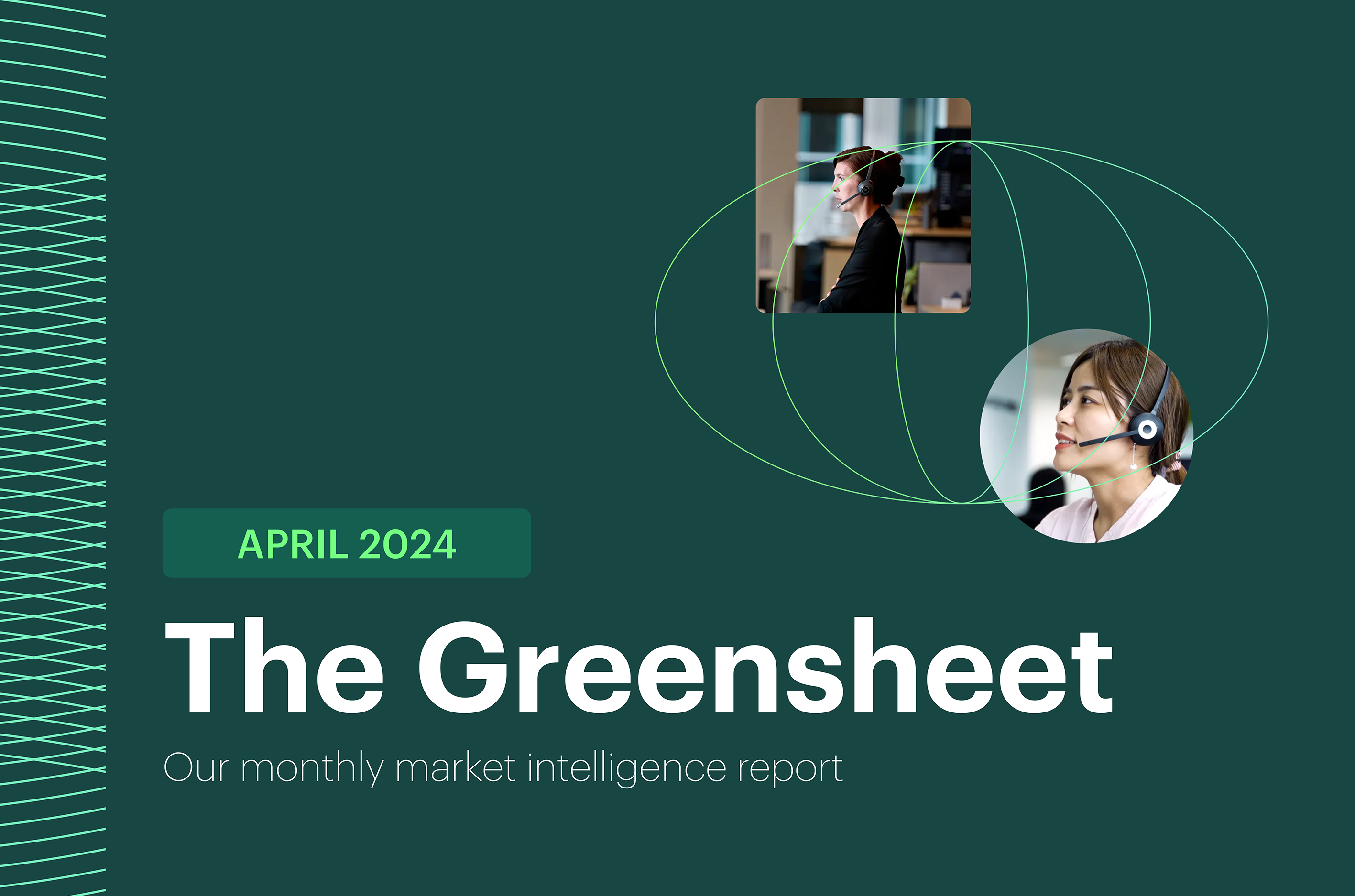The Greensheet is Fusion Worldwide's monthly market intelligence report detailing the most significant developments across the integrated circuit, central processing unit, and hardware commodity supply chains. Here are some key takeaways from our latest report:
- SK Hynix, Micron, and Samsung are focusing on HBM production, causing tight DDR3 supply.
- Hardware market demand varies, while cryptocurrency trends create further constraints for GPUs.
- Cryptocurrency miners seek high-performance CPUs, which causes robust effects on AMD product demand.
- A companywide shipment pause impacted Analog Devices' availability.
With major players shifting manufacturing to support emerging technologies, the electronic component industry may be in for a turbulent quarter. Variations in hardware and CPU market demand, compounded by unforeseen trends in the cryptocurrency industry, further demonstrate the volatility of supply chain forecasting.
Learn more about the market happenings in the full report below.
Improved Availability Brings PC Memory Module Prices Down
Activity has slowed since March, prompting vendors to release extra supply to reduce high inventory levels. As a result of the improved availability, memory hardware prices are dipping by around two to three percent.
Excess supply has been a continuous concern for the market, and module costs may dip further in the coming months. PC module prices will likely stay soft as projections for the product demand environment are flat.
Rising Demand and Supply Constraints Fuel Surge in DDR Prices
Cuts to D4 production have pushed end customers to transition to D5, expanding demand for D5s. Because of this trend, manufacturers will likely increase D5 costs by 5%-10% within the quarter while DDR3 is expected to increase by at least 10%.
NANYA Technology prices are already increasing sharply, with DDR3 1G and 2G seeing costs rise by 50% in the past two quarters. AI is driving this trend as demand from customers in this vertical remains high. SK Hynix and Samsung recently stated that they would stop DDR3 production to focus on HBM products. As more prominent brands, such as Micron, follow this trend, companies like NANYA can expect demand for their products to expand.
Samsung is also reportedly withholding a significant portion of its stock, which will only tighten supply conditions. As demand for DDR3 and DDR4 continues to spike, shortages will likely cause another pricing surge within the next two quarters.
Customers Seek Alternatives for DRAM and NAND Amidst Allocation Challenges
Chip level memory prices, specifically for DRAM and NAND, continue to expand as certain manufacturer costs have risen by as much as 20%. Customers must submit six-month forecasts to get firm DRAM and NAND supply allocations. Due to the industry's dynamic nature, long-term forecasts are challenging to deliver. Customers are consequently turning to the market to secure supply.
For DRAM, booking costs are high while market pricing is more stable as availability is steady. However, demand and availability will fluctuate this month due to major memory manufacturers like SK Hynix planning a price hike.
Hardware
Manufacturers Continue to Increase Pricing Amidst Softening Demand
Demand has remained soft since the end of the Lunar New Year because manufacturers have increased hardware component pricing. End customers report that the supply of lower-demand parts is stable. However, the allocation for high-capacity SSDs, 7.6T and above, is limited.
Manufacturers plan to increase prices by another 15% to 20% in the 3rd Quarter (April – June). While demand has varied so far, manufacturers base this price increase on trends forecasted for the year's second half. Predictions indicate that the demand for cloud service industry services will be robust.
HDD manufacturers are also looking to implement another cost adjustment, but this time in the 5% to 7% range. Costs for high-capacity SAS drives have risen by about 2%. Booking lead times are extending as production cannot currently satisfy demand.
Cryptocurrency Demand Impacts GPU Supply
Increasing demand and a tight supply of GPU chipsets led to extended lead times for select GPU series. AI-related activity is driving demand, but an uptick in cryptocurrency markets is contributing to GPU constraints.
Crypto customers are currently concentrating on models with higher hash rates and memory. The most in-demand items are the 3090/4090 models, as they are the main cards being used today in mining. As supply tightens, and parts become increasingly difficult to obtain, companies will turn to the 4080/4070 Ti and Super. Workstation GPUs, like the RTX A5000 ADA, would be the following targets for a wave of demand if this trend continues.
Availability will change further as new products hit the market this year. At the company's annual GTC conference, Nvidia recently unveiled its latest GPU series and models. Nvidia has not yet announced the exact launch date.
Intel PC Market Driven by Cost Savings, with Spotlight on Repair Orders and Gaming CPUs
Demand for cost-saving opportunities is driving demand, particularly among Intel's Mobile and Desktop customers. Availability in the market has increased, and customers are taking advantage of the chance to negotiate pricing.
Spot demand mainly stems from customer repair orders. This trend increased demand for older series like the 11th Gen Tiger Lake mobile CPU. Supply is consequently limited compared to the newer series. The most common transactions are for the non-IPU series on the Core i3, i5, and i7 series.
The 12th Gen Alder Lake gaming mobile CPU, i5-12450H / SRMAQ, has become a hot product because it is cost-effective and has exceptional performance. This surge in popularity will likely continue in the coming months, instilling optimism about Intel's product performance.
Activity surrounding the 12th and 13th Gen Mobile Desktop CPU has held steady, although transactions have been minimal. Customers continue to weigh their options. Demand for the 14th Gen Meteor Lake series is still soft.
Intel Server Market Supply Improves Towards Quarter End
Intel recently released more allocation for popular products like the 2nd Gen Cascade Lake and Cascade Lake Refresh. The 3rd Gen Ice Lake series supply has also stabilized, inspiring confidence in Intel's ability to meet market demands.
However, despite consistent supply, the market adoption rate for the 5th Gen Emerald Rapids has stayed slow. Vendors remain conservative in their forecasting but predict demand will increase in the second half of the year.
Cryptocurrency Miners Increase Demand for AMD Products
Advanced Micro Devices (AMD) has seen a notable surge in demand for its Ryzen 9 7950X processor. This surge comes from cryptocurrency miners sourcing high-performance CPUs. The mining industry has also increased demand for AMD's Rome series. Customers outside the mining industry are reluctant to invest in AMD CPUs at current market prices.
Meanwhile, Milan series demand is minimal. The few models experiencing spot demand are the EPYC 7713, EPYC 7643, EPYC 7513, and EPYC 7543.
Much of AMD's server CPU demand focuses on the Genoa series. This series encompasses high-performance server CPUs tailored for applications in high-performance computing (HPC) and AI-related devices. The processors seeing the most demand are the EPYC 9684X and the EPYC 9384X, because of their applications for AI.
Integrated Circuits (IC)
Analog Devices Resumes Shipments After Pause
Analog Devices announced a slowdown in shipments from March 15th to March 24th. Existing orders experienced delays, although the extent of the impact varied depending on the warehouse location. While the slowdown period has officially ended, operations will take four weeks to return to 100% capacity.
The pause was due to the integration of Maxim Integrated Products and Analog Devices' operations. While Analog Devices acquired Maxim over three years ago, the transition to Analog Devices' database took longer than initially anticipated.
NXP Customers Experience Fluctuating Pricing and Lead Times for MCUs
Since the beginning of 2024, NXP has steadily adjusted pricing for MCU products. After several negotiations, most end customers have received new contract pricing. For FS32 MCUs, which have historically had high demand, lead times have stabilized, and market supply is healthy.
For the aging IMX6 model MCU, lead times have stretched alongside cost adjustments on contract pricing. Supply is limited for this series as NXP gradually shifts production focus to newer products. The IMX8 series will become the new mainstream focus and standard selection for new projects.
However, demand forecasts for the new and older series will change as demand from Chinese-based electric vehicle (EV) makers may decline. The government is encouraging EV companies to increase support for local chips. This shift in the market will impact NXP, which has historically been a leading player in the automotive application space. The company may implement production and pricing changes to adjust to customers transitioning away from their products.


